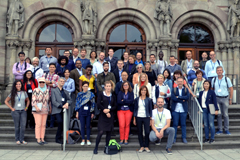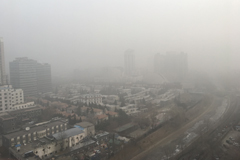Research of Air Pollution in China Presented at the Annual Conference of the International Network for Economic Research
2018.11.22
The Annual Conference of the International Network for Economic Research (INFER) was held between September 5 and 7, 2018, at the University of Göttingen in Germany. Eiji Yamada, research fellow of the JICA Research Institute (JICA-RI), presented an interim research result on the JICA-RI research project, “A Study on Urban Air Pollution in Asia” at the conference. INFER is a network of about 1,000 economists from Europe and all over the world. There were three keynote speakers at this year’s annual conference, and 20 parallel sessions. Approximately 90 people attended the conference, including researchers from universities, research institutions and central banks.

Participants pose at the Annual Conference of the International Network for Economic Research(Photo provided by INFER)
Yamada took the podium at a parallel session on the 6th. The presentation, titled “The Impact of Domestic Migration Policy on Economic Welfare and Air Pollution: A New Spatial Equilibrium Approach for China,” was based on the results of analysis made for a working paper that he is writing with the title “A Spatial Equilibrium Analysis of Air Pollution in China” as part of the JICA-RI’s research project.
This project studies the state of Asian countries regarding the emission of harmful substances, such as PM2.5, which have been increasing along with the rapid economic growth and urbanization in the region. The objective of the project is to analyze the factors for the emission of pollutants and to consider policies for the improvement of air quality. Yamada is analyzing air pollution in China by applying spatial economics methods—an analysis of the geographic distribution of economic activity—to environmental issues.
The paper presented at the conference built a theoretical model of the Chinese economy, which consisted of numerous regions. It then carried out a series of simulation experiments on how intercity transport costs and the emission control policy at the local level affect the distribution of economic activities and air pollution. For example, it revealed an unintended environmental benefit of the recent expansion of China’s transportation network. A simulation assuming that no new road construction happened since 2007 by 2013 (in other words, intercity transport costs remained at the same level as in 2007) showed that the level of aggregate exposure to air pollution (a proxy variable for potential health problems caused by air pollution) would have been greater due to the relationship between pollution and the geographical distribution of populations.

Smog hanging over the capital city of Beijing, China
As results obtained thus far, Yamada reported that the theoretical framework of spatial economics can be used to analyze the spatial distribution of economic activities and pollution under realistic circumstances. He also said that policies for reducing regional inequality had the possibility of improving overall efficiency. He concluded the presentation by saying that there was a need to carry out the following analyses as next steps: 1) the impact of the selection of parameters for the simulations, 2) the impact of migration costs, and 3) the impact of an alternative scenario for road development.
Useful comments were obtained in the discussion that followed the presentation, such as on the assumptions related to modeling domestic migration, methods for modeling the spatial diffusion of air pollution, the role of railroads and the interpretation of the results.

事業事前評価表(地球規模課題対応国際科学技術協力(SATREPS)).国際協力機構 地球環境部 . 防災第一チーム. 1.案件名.国 名: フィリピン共和国.

事業事前評価表(地球規模課題対応国際科学技術協力(SATREPS)).国際協力機構 地球環境部 . 防災第一チーム. 1.案件名.国 名: フィリピン共和国.

事業事前評価表(地球規模課題対応国際科学技術協力(SATREPS)).国際協力機構 地球環境部 . 防災第一チーム. 1.案件名.国 名: フィリピン共和国.

事業事前評価表(地球規模課題対応国際科学技術協力(SATREPS)).国際協力機構 地球環境部 . 防災第一チーム. 1.案件名.国 名: フィリピン共和国.

事業事前評価表(地球規模課題対応国際科学技術協力(SATREPS)).国際協力機構 地球環境部 . 防災第一チーム. 1.案件名.国 名: フィリピン共和国.
scroll